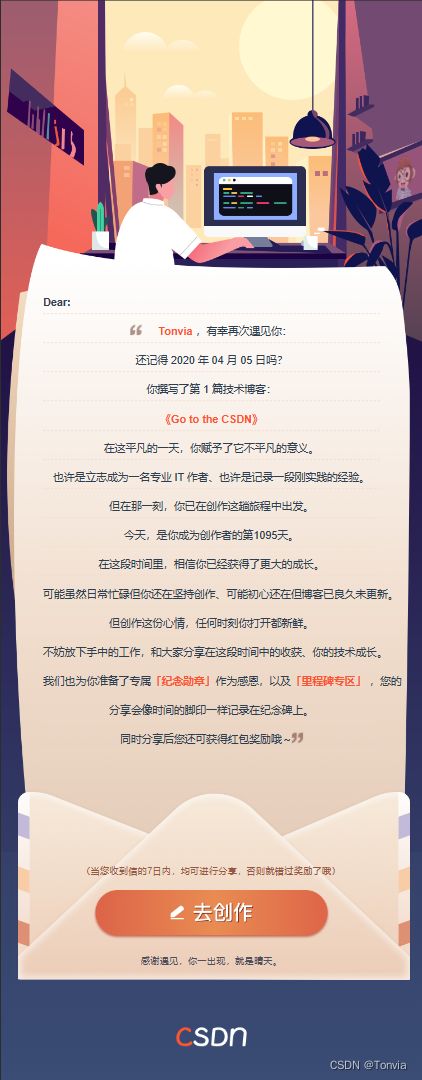CSDN,有幸遇见 ——我的三周年创作纪念日
一生二,二生三,三生万物
三年,与 CSDN 的相遇相识相知——
前两年都没写,一是没纪念的概念,二是纪念日这天每年总是清明节。
还有就是不知道有勋章((
Meet 遇见
那年,我六年级,已加入了一年半的信息学竞赛。
是一次撞见,我发现了这个能指导我不会做的题目的网站。
是童心的好奇,从此让我打开了对 CSDN 的无尽探索,
一个又一个地寻找着键盘上的字母,我织出了那稚嫩懵懂的第一篇 blog ——《Go to the CSDN》。
Gain 收获
随着打字速度的加快和心智的逐渐完善,我不知不觉地习惯使用 CSDN 写 blog,虽然一共只写了 71 篇,但可以不吝啬地说,都是用心敲出来的(虽然很多内容多但点赞很少)。
尽管这仅有的 143 次点赞中有十多次是自己点的,但也有许许多多各行各业的强者的支持,尤其有两个是 CSDN学习 给予的,备受鼓舞。
在这里郑重感谢所有评论、点赞、收藏、关注的支持啊!
未来是一种憧憬呢。
Life 日常
还不能说创作已经是我生活的一部分了,但它一定已经成为了我生命中的一部分。
创作像是一种总结,是自己与思想的再一次碰撞。创作也是一种乐趣,尤其是收到支持时的莫大鼓舞,我的生命离不开创作。
去年第一次参加的 CSDN 竞赛,进入前十,得到了 CSDN 帆布包的馈赠,以前也在其他网站上参加过类似比赛,但像 CSDN 这样信守承诺的举办方并不多,可见“成就一亿人的社区”并非浪得虚名。“细节决定成败。” 这一点,CSDN 成功了,当之无愧。
Achievement 成就
提示:你过去写得最好的一段代码是什么? 请用代码块贴出来
倒还没感觉写过什么特别突出的代码,那就贴一份 目前唯一一道不看题解就做出来的黑题 吧。
靠模拟退火调参数调出来的,为此还在CSDN写了一篇模拟退火算法的 blog
话说写的这篇 blog 目前还是我写的文章中访问量最高的…
第一次 AC 提交时间:2022-11-18 20:48:07
#include顺带贴一手正解代码。
#include 来源:IOI 2006 国家集训队论文「王栋 ——浅谈平面 voronoi 图的构造及应用」。
Phantasy 憧憬
还是希望能保持在 CSDN 不规律性更新吧,既然有缘相遇,何不一同随行?
不过可惜一个铁粉都还没有额…
Encourage 激励
努力学习,追求卓越。
前途是光明的,道路是艰难的。
前行不往回顾,勇进不忘调整,跋涉不忘反思。
放个套话:你的支持是我创作的最大动力!
5000字了啊
这个就不删了 乐
Tips
- 您发布的文章将会展示至 里程碑专区 ,您也可以在 专区 内查看其他创作者的纪念日文章
- 优质的纪念文章将会获得神秘打赏哦

